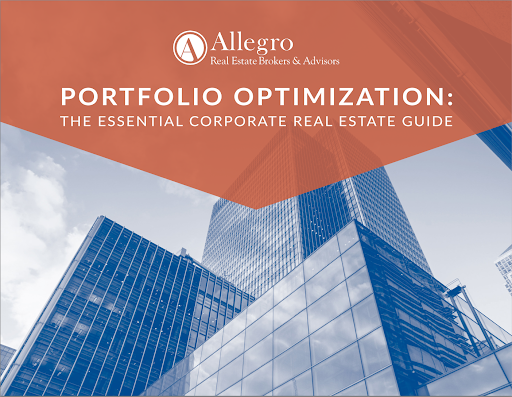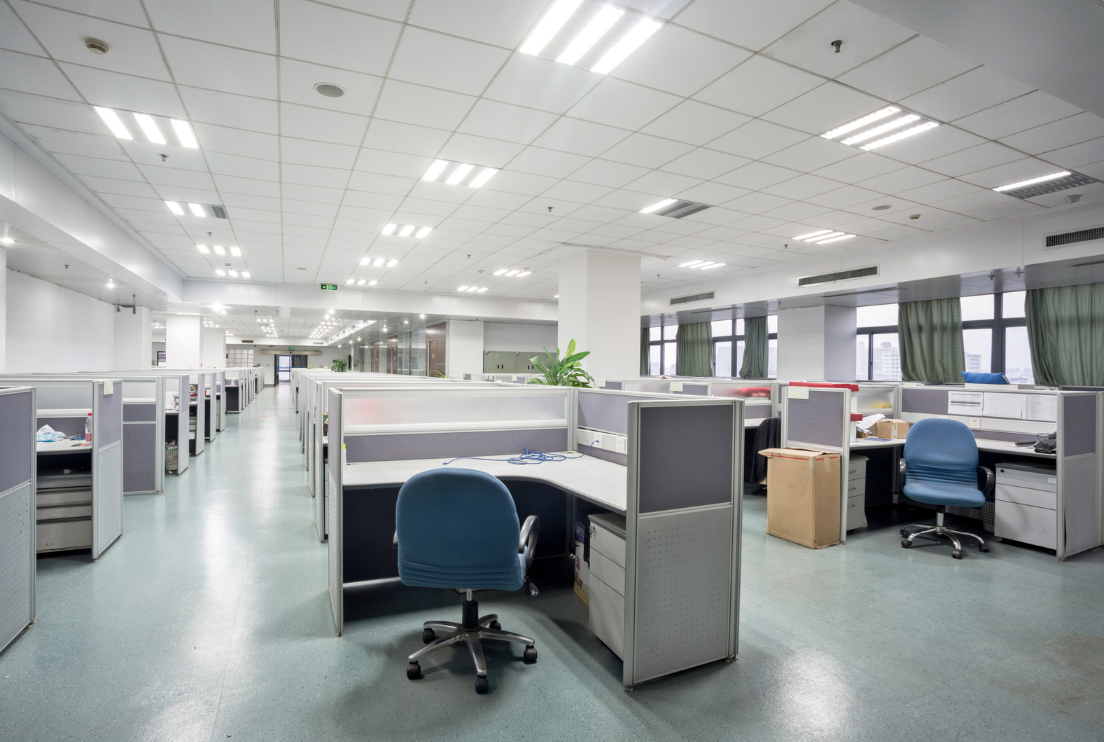COVID-19 has impacted all aspects of business, including real estate portfolios. This year, you may have experienced a disrupted supply chain, decreased revenue, and slower business activity altogether. Don’t worry. You’re not alone.
Office workers are likely working remotely part- or full-time, leaving vacant office space. If your facility is customer facing or has required employees to return to the office for other reasons, you’ve had to make changes to enable physical distancing and other health protocols. Some of these measures may include investments in your office space and furniture systems.
These are all short-term adjustments with no clear return-to-normal in sight. Balancing the current, volatile situation with its impact on a foggy future business outlook can feel challenging.
Many corporate real estate decision makers have reached out to us with valid real estate concerns, such as:
- How should I approach an upcoming lease expiration or other lease right notice dates?
- Can I negotiate rent relief with my landlord? If so, will I need to make a longer term commitment to my space?
- How can I get out of my lease? Should I try to negotiate a lease buyout or take my space to market for sublease?
- With many employees working from home, should I consolidate space or do I need to add more square footage to create physical distancing through hard-walled offices and larger workstations?
Read on for advice on these questions and others facing significant real estate challenges and questions during this period of uncertainty.
Long-Term Real Estate Decisions
In a time of significant uncertainty, both for your business and for the market in general, it’s important to avoid making significant long-term real estate decisions based on short-term conditions.
It may feel overwhelming to determine what short-term decisions you can make to set yourself up for long-term success, but it’s all about balancing these two aspects. You need to avoid overcorrection when the pendulum has swung so far, as it has right now.
You may see news articles and social media posts calling for the “end of the physical office,” claiming that working from home will be the “way of the future.” In reality, it’s too soon to decide that technology will replace face-to-face interactions for businesses in the long-term.
While it may be your “gut reaction” to implement the below solutions, we recommend waiting out the storm before investing your capital in these changes, unless you can economically accomplish these decisions.
Evaluate sublease opportunities carefully.
Many organizations are pursuing sublease arrangements for portions of their space, which they hopefully will not regret post-pandemic.
While subleasing might seem like the perfect solution to generate extra revenue during this slowdown, balance that decision with the potential long-term impact. Once public health officials confirm it’s safe and you’re comfortable fully reopening the space, you may be left with someone else occupying it. If clients and customers are ready to visit your location, you may not be able to accommodate their expectations. Meanwhile, the demand for sublease space is currently weak because many businesses are in a wait-and-see mode.
Desk-sharing.
Desk-sharing, or hotelling, is a system that allows individual employees without assigned offices to “pre-book” or “check in” to access a workstation when working in the office. Some organizations want to reduce the number of assigned workstations and, instead, want to adopt a hybrid of work-from-home and work-in-office system.
This solution can be affordably implemented in your office space, but be cautious to avoid investing in all new desks, or selling off cubicles and desks.
We’re seeing two opposing views of this concept.
- On one hand, some organizations are adopting hoteling to reduce office space.
- On the other hand, more risk-averse organizations and their employees are uncomfortable with sharing desks due to the pandemic. They are instead taking extra efforts to maintain physical distancing and other health precautions in case employees return to the office. This approach requires more time evaluating options.
Hold off on major renovations and expansions.
While there are certain additions and amenities that your company may want to invest in in the future, it’s important to not overreact to the current environment and avoid spending all your resources on “safe-proofing” assets.
For example, certain organizations recommend upgrading your building’s HVAC system to improve air filtration, circulation and quality, but the cost is significant—averaging between $6,000-$12,000 per 1,000 square feet. While this could be a long-term strategy to enhance health and safety, you may want to wait to see what the future holds post-pandemic.
Since the start of COVID-19, 88% of employers across the country have mandated or encouraged their employees to work from home. One reason many expect to stay remote into 2021 is that they don’t have the space to accommodate safe physical distancing. As a reaction, we’re seeing some organizations expand their square footage. While this may be something to consider in the coming years as health protocols become clear and consistent, we advise caution before making a massive investment based on today’s circumstances.
Short-Term Real Estate Needs: Health and Safety
In the short-term, there are several ways you can economically enhance your current assets to enable teams to connect in person.
Stay up-to-date on the latest health and safety information.
Learn about the requirements of your state and county, and be sure to check them regularly as they are subject to change. Communicate with your property manager and check in with the Center for Disease Control and Prevention (CDC) for the most up-to-date guidance on how to optimize your workplace for health and safety.
Communicate with property managers and building owners.
Communicate with your current landlord or property manager to develop a plan to safely bring your employees back in the office. Ask them questions such as:
- How will social distancing be implemented throughout the building common areas?
- What technology will ensure your facility remains safe and compliant?
- What is the building’s plan in the case of a positive case/cases of COVID-19?
- Are building owners upgrading and maintaining building systems, such as enhanced air filtration, touchless elevators and doors, and similar health-oriented innovations?
Embrace transparency within your organization.
To build trust with your employees and effectively manage risk, it’s important to embrace transparency. As you communicate with your landlord or property manager during this time, openly communicate with your employees and update them on processes.
As leaders, in times of uncertainty, it’s valuable to exhibit vulnerability. Embrace honesty; acknowledge that you don’t know everything and are continuously monitoring the latest scientific data and health guidelines to determine the best way to operate during the pandemic.
Seek upgrades that enhance health and safety.
While full-time work-from-home may be a temporary trend, the new focus on building sanitation, air filtration, and safety will be critical (and in some cases, regulated, now or in the future) even after a COVID-19 vaccine is widely available. While we recommend holding off on massive investments (such as a brand new HVAC system), there are certain steps you can take to better the air quality and sanitization in your building today.
Consider the following:
- Change air filters more regularly than in the past.
- Increase ventilation with open doors or windows.
- Use air purifiers.
- Incorporate plants into your design. That’s right, indoor plants are natural air purifiers and can improve the air quality in your office.
Real Estate Opportunities to Consider
If your assets are currently not in use, now is the time to make incremental and economical changes that will prepare them for that day when doors are open to employees, customers, and clients. Establish health protocols, assign workspaces to accommodate physical distancing (such as staggered seating) and address deferred maintenance and improvements while the facility is sparsely populated.
Though we currently recommend a “wait-and-see” approach to significant and costly real estate decisions, it’s important to make your office a safe and inviting place for employees to return to when the time is right.
Adding upgrades to your space, kicking off any renovations, or “sprucing it up” a little will go a long way. Considerations include:
- Improve the customer experience for traffic to your business.
- Update facilities to improve operating efficiency.
- Accommodate new equipment.
- Improve energy efficiency.
- Consider cultural impacts and modifying your space to attract employees back to the workplace.
- Apply health protocols and make your space comfortable to your most sensitive employees.
Align Your Real Estate with Your Business Strategy
There’s a lot to think about as you strategize your real estate portfolio in the future. Whether you’re planning out weeks, months, or years ahead of time, the best solution to optimizing your real estate portfolio is to have a trusted partner on your side to advise and help manage your assets.
Download our free guide, Corporate Real Estate Portfolio Strategy: Your Business’ Competitive Advantage, to help you through your asset evaluation today.







